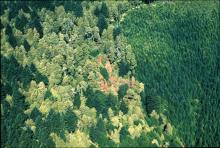See:
Tanoak (Notholithocarpus densiflorus) - Sudden Oak Death
Cause Sudden Oak Death, caused by the fungus-like organism Phytophthora ramorum, has never been found on oak or any Quercus spp in the PNW. Oregon white oak (Q. garryanna) does not appear to be very susceptible when challenged with the pathogen in lab tests. Lethal bark cankers, however, have develop on susceptible members of the oak family throughout the central coastal counties of California, including black oak (Quercus kelloggii), coast live oak (Q. agrifolia), Holm oak (Q. ilex), southern red oak (Q. falcata), and Shreve's oak (Q. parvula var shrevei). Dying trees have been observed in urban and rural forests and woodlands.
Tanoak (Notholithocarpus densiflorus) is very susceptible and many dead and infected trees have been found in a small area of Curry County in southwest Oregon. A few dead and infected wild rhododendrons and evergreen huckleberry were also found as well as incidental leaf infection on salmonberry, cascara, myrtlewood, and poison oak (stem cankers). Since the initial discovery, Oregon has focused on limiting the spread of the disease in Curry County through early detection, monitoring, and eradication of symptomatic tanoak trees. Despite these efforts, the quarantine area in Curry County has expanded many times since 2001 from 9 sq. miles to almost 50% of Curry County. The rate of disease spread increased most dramatically in 2014 requiring the quarantine area to nearly double in 2015. In 2015 a new outbreak was detected in the Cape Sebastien area. More recently, a new outbreak in the Port Orford area was found in 2021 on tanoak trees several miles outside the quarantine zone. Follow up surveys found over 100 infected trees and resulted in the treatment of 580 acres of forest land. This was considered a new introduction from the original outbreak and a new 3 sq mile emergency quarantine zone was established. Each of these three outbreaks was initiated by a different clone of the pathogen.
The host list for this organism includes many different plants. Tip dieback and/or leaf spotting occurs on bigleaf maple, Camellia, cascara, coast redwood, Douglas-fir, honeysuckle, horsechestnut, huckleberry, kinnikinnick, myrtlewood, Pacific madrone, Pieris, poison-oak (stem cankers), rhododendron cultivars, salmonberry, Viburnum and others (Note: those in bold are found infected in the nursery most often). Federal and international quarantines have been established to prevent the spread of this pathogen in soil and infected plant material.
If you suspect you have seen a P. ramorum-infected plant in Oregon, call the Invasive Species Hotline, 1-866-INVADER (1-866-468-2337).
Symptoms Oak trees appear to die rapidly, turning from an apparently healthy green to brown within a few weeks. Leaves may at first have a darkened petiole. Dead leaves may remain on trees for up to 1 year after tree death. The disease is characterized by brown or black discolored patches of bark on the lower trunk with an exudation of viscous sap from the bark. Bleeding usually is aboveground within 3 to 15 ft of the soil line. A sunken or flattened area may be observed below the bark. A distinctive dark-reddish canker margin can be seen in the bark and wood.
Cultural control Control efforts in Oregon are focused on containing the pathogen where it is found in forests and preventing new infections beyond the current quarantine area. Within the quarantine area, the quarantine requirements vary depending upon your location. For the most current quarantine requirements, please contact the Oregon Department of Agriculture.
- Do not transport firewood, other susceptible plant material, or soil from diseased areas in California or southwest Oregon.
- Wash shoes, vehicles, bikes, etc. if you visit infested areas of California or southwest Oregon.
- Contact the Oregon Department of Agriculture if you see or suspect trees or plants in Oregon with symptoms of this disease.
- In Oregon, Notify the ODA's Nursery and Christmas Tree Program when importing nursery stock from any out-of-state source.
- Purchase nursery plants only from nurseries certified as free from P. ramorum according to federal regulatory standards. A certified nursery will have an official certification shield.
Chemical control Although fungicides are used as a general preventative treatment, it is not recommended for oaks in Oregon.
Note This disease and fungus are different from the outbreak of P. cinnamomi in southwest Mexico that has similar symptoms on oak.
Reference Grünwald, N.J., Garbelotto, M., Goss, E.M., Heungens, K., and Prospero, S. 2012. Emergence of the sudden oak death pathogen Phytophthora ramorum. Trends in microbiology. 20:131-138.

